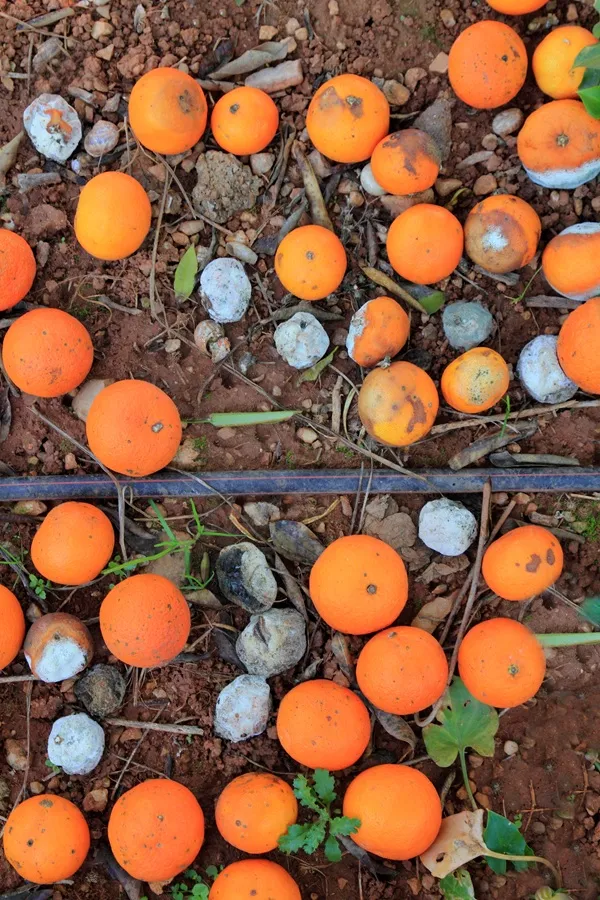Table of Contents
We have more than enough food to feed everyone, yet millions of tons rot unused every year at the source. Let Food Pulse help — blending data, analysis, and practical action.
🌍 The Global Farm-Level Food Waste Crisis
Every year, 30–40% of global food production goes to waste. A huge part of that happens before food even leaves the farm.
- Fruits and vegetables are the biggest victims — they’re perishable, delicate, and often overproduced.
- Studies estimate 25%–35% of fruits and vegetables never reach markets.
- Common causes include:
- Overproduction due to market uncertainty or weather patterns.
- Labor shortages — not enough workers to harvest on time.
- Strict cosmetic standards from supermarkets (misshapen or slightly bruised produce gets rejected).
- Price drops — when it’s cheaper to let crops rot than to pick and transport them.
- Weather events causing sudden harvest overlaps or damage.
So, when you see thousands of apples, mangoes, tomatoes, or plums rotting on the ground, that’s not just lost food — it’s also lost water, energy, fertilizer, and labor.
💡 Ideas to Rescue and Repurpose Surplus Farm Produce
Food Pulse could become a powerful connector between farms, volunteers, local processors, and community organizations. Here’s a structured model:
1. Volunteer Harvest Networks (“Gleaning Programs”)
- Volunteers, students, or community groups visit farms (with permission) to collect fallen or unharvested produce.
- This produce can then go to:
- Food banks (for immediate distribution)
- Processing centers (for dehydration, freezing, or juicing)
Examples:
- “Gleaners” in Canada and the US already rescue millions of pounds of produce yearly.
- The UK’s Feedback’s Gleaning Network coordinates volunteers to save farm surpluses for charities.
2. Local Processing Hubs or “Micro Food Factories”
- Set up small mobile units or co-op facilities that can:
- Freeze or dehydrate fruits and vegetables.
- Convert imperfect produce into purees, juices, or jams.
- Create dried snacks or powders for longer shelf life.
- These can be powered by solar energy and run seasonally.
3. Partnerships with Startups and Food Entrepreneurs
- Food Pulse can help link surplus produce with small-scale processors who make:
- Smoothies, sauces, chutneys, or baby food.
- Value-added products (like sun-dried tomatoes or dried mango slices).
4. Composting & Animal Feed (Last Resort)
- Even produce that’s no longer edible can be diverted for composting or animal feed — keeping it out of landfills.
🏛️ What Governments Can Do
Governments play a key role in changing incentives and building infrastructure:
- Tax Incentives
- Offer tax deductions or credits for farms donating surplus produce.
- Reduce liability fears (like the US Good Samaritan Food Donation Act that protects donors).
- Farm Waste Grants
- Provide small grants or cost-sharing programs for farms to install on-site cold storage or dehydration units.
- Public-Private Partnerships
- Encourage collaboration between farmers, food banks, tech platforms (like Food Pulse), and local governments.
- Awareness Campaigns
- Promote the idea that “ugly” or surplus produce is still nutritious and valuable.
- Data & Coordination Systems
- Use real-time tracking platforms (like Food Pulse) to map surplus zones and coordinate pickups before spoilage.
🧭 Changing the Mentality of Farmers and Homeowners
This is crucial — technology only works if people are willing to share their surplus.
Common Concerns:
- Liability or legal risk if someone gets hurt on their property.
- Embarrassment or privacy issues — some may not want others to see “waste” on their farm.
- Mistrust or lack of awareness — they may not realize volunteers can safely collect and repurpose the food.
How to Educate and Encourage Participation:
- Awareness & Recognition
- Highlight that sharing surplus isn’t charity — it’s sustainability and community leadership.
- Create badges or recognition for participating farms (“Zero-Waste Farm Partner”).
- Ease & Safety
- Make the process simple:
- Farms post available surplus on Food Pulse (with photos, quantity, timing).
- Volunteers sign waivers and follow safety rules.
- Coordinators handle pickup logistics.
- Make the process simple:
- Transparency
- Provide visibility into what happens with the collected food (photos, reports, or “impact meters” showing meals saved).
- Mutual Benefit
- Offer farms data insights, promotion, or small incentives.
- For homeowners: show them they can clean up their property, avoid pests, and help neighbors in need.
🌱 How Food Pulse Fits In
Food Pulse could act as a “real-time rescue map.”
- Farmers or homeowners list surplus produce (location, quantity, type, pickup window).
- Verified volunteers or food recovery organizations get alerts.
- Collected items are tagged for use — fresh distribution, dehydration, freezing, or composting.
- The platform can even auto-suggest nearby processors or charities.
This builds an ecosystem of rescue, reuse, and regeneration.
❤️ The Vision
“Every apple, mango, and tomato deserves a purpose — not a landfill.
Food Pulse connects people, technology, and compassion to make sure food feeds lives, not waste bins.”








